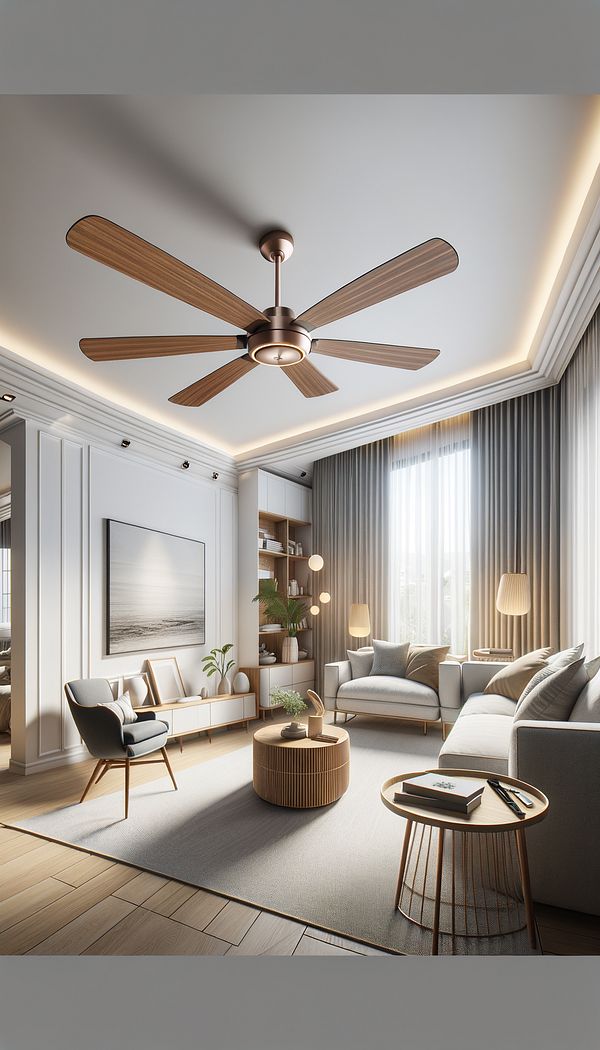What is a Ceiling Fan?
A ceiling fan is a mechanical fan mounted on the ceiling of a room.
Description
A ceiling fan represents both a piece of architectural elements and a versatile lighting fixture, blending function with style. It consists of rotating blades that circulate air in a room to cool it down during warm months or redistribute warm air during cooler periods. Modern ceiling fans often come with a light fixture in the center, serving as a dual-purpose element that illuminates and ventilates. Ceiling fans are available in a multitude of styles, sizes, and features, making them suitable for various design styles.
The design of a ceiling fan is crucial as it can significantly affect a room's aesthetics and comfort level. Factors such as blade length, material, color, and additional features like remote controls or energy-efficient light bulbs contribute to its functionality and compatibility with the room’s decor. Installing a ceiling fan can offer energy savings by reducing the need for air conditioning and heating.
Ceiling fans can be seamlessly integrated into almost any room, including bedrooms, living rooms, patios, and kitchens. They complement the interior design by adding a layer of visual interest while performing a practical role in maintaining comfort.
Usage
In a minimalist bedroom, a sleek, white ceiling fan complements the clean lines and neutral colors of the room, providing both air circulation and lighting. For outdoor living spaces, weather-resistant ceiling fans with wider blades offer effective cooling for patios and decks. In kitchens, compact fans with bright, energy-efficient lighting ensure a comfortable cooking environment.
FAQs
-
Can a ceiling fan be used in any room?
Yes, ceiling fans can be used in almost any room, including outdoor areas, as long as they are designed for the specific conditions of the space.
-
Do ceiling fans help in reducing energy costs?
Indeed, ceiling fans can help reduce energy costs by making a room feel cooler and reducing the need for air conditioning during warm months, and redistributing warm air during cooler periods.
-
Are there ceiling fans that also serve as a light source?
Yes, many modern ceiling fans are equipped with a light fixture in the center, making them a versatile option for lighting and air circulation.
-
What factors should be considered when choosing a ceiling fan?
Factors such as the room's size, ceiling height, fan blade length and material, style, and additional features like lighting or remote controls should be considered to ensure the fan's efficiency and aesthetic harmony with the room.
-
Can ceiling fans be used outdoors?
Yes, but it's important to choose ceiling fans specifically designed for outdoor use, which are made to withstand weather conditions like moisture and varying temperatures.
Practical Application
When selecting a ceiling fan, consider the room's size and ceiling height to determine the appropriate blade length and fan size. For rooms with higher ceilings, a downrod can be used to lower the fan to an optimal height. Choose a fan style that complements the room's overall décor to enhance aesthetic appeal. Also, look for energy-efficient models to maximize savings on heating and cooling costs.
-
Architectural Elements199 articles
-
Design Styles478 articles
-
Lighting111 articles
-
Decorating Principles & Elements330 articles
-
Outdoor & Garden14 articles
-
Finger JointA finger joint is a woodworking joinery technique used to connect pieces of wood end-to-end.
-
DraperyDrapery refers to heavy curtains made of fabric, used to adorn or cover windows.
-
Vis-A-VisVis-à-vis in interior design refers to furniture or objects facing each other.
-
Mosaic TilesMosaic tiles are small, often decorative, pieces of tile used in creating images or patterns on floors, walls, and other surfaces.
-
Tilt TopA tilt top refers to a table whose top can be vertically adjusted or tilted.
